User Guide
Welcome to the Jira Service Desk Language Translation! On this page you can learn, what you can do with it.
1. Translating, the basic functionality of the app
When a customer raises a request and uses a language that is not defined as an agent language in your service desk, then it is translated to your main language. Default is English.
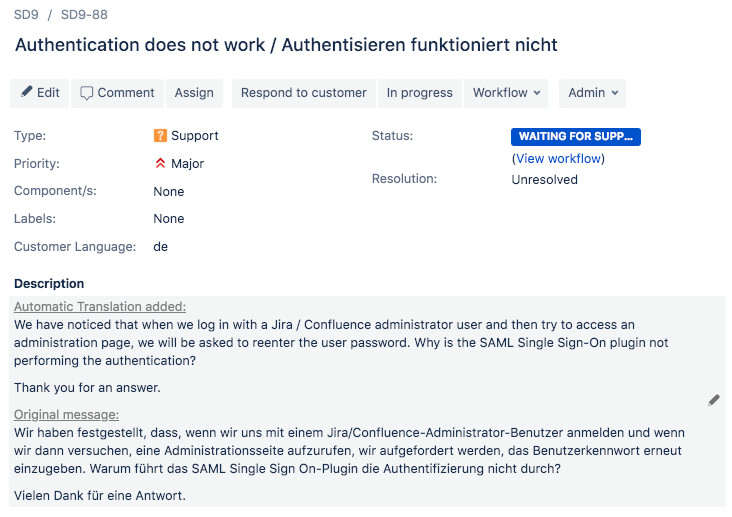
Both are translated, the summary and the description. Both show also the original text.
On issue creation the customer language is determined. Any text send out as an answer to the request (comment) that is not in this language, is translated to this language. (If not, than your admin has probably deactivated the feature to translate outgoing messages).
2. A new custom field: "Customer Language"
As you see in the image directly above the description field there is a new custom field containing the customer language. If you can't see the field than it might be missing on the view and you can ask your administrator to switch it on.
This field you can use in JQL searches, automation or you can build queues with it, that only contain requests in specific languages. More about this you find here.
Have fun!
3. Selecting a translation mode
Language Translations for Jira Service Desk can post ticket translations in two different modes. Admins can decide which of these two modes will be active from the Language translation options in the Project Settings.
Only one mode can be active for a project at any given time. However, it's possible to enable different modes for different projects.
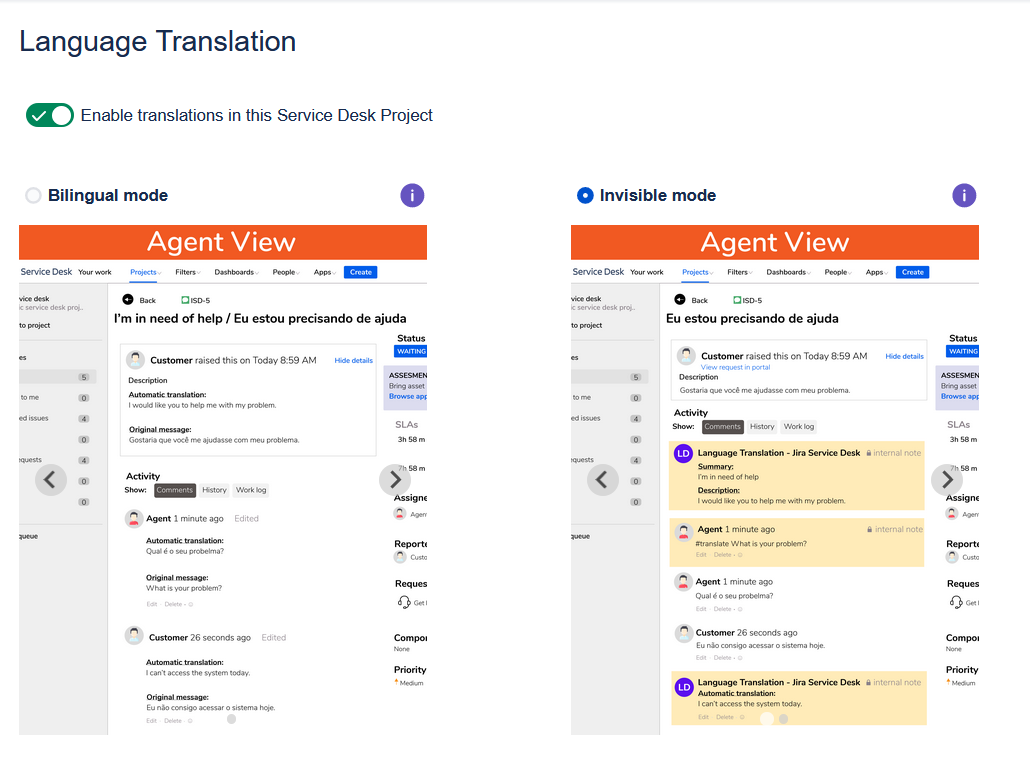
Bilingual mode
The bilingual mode is selected by default. It will show all the original messages alongside their automated translations to both the agent and the customer.
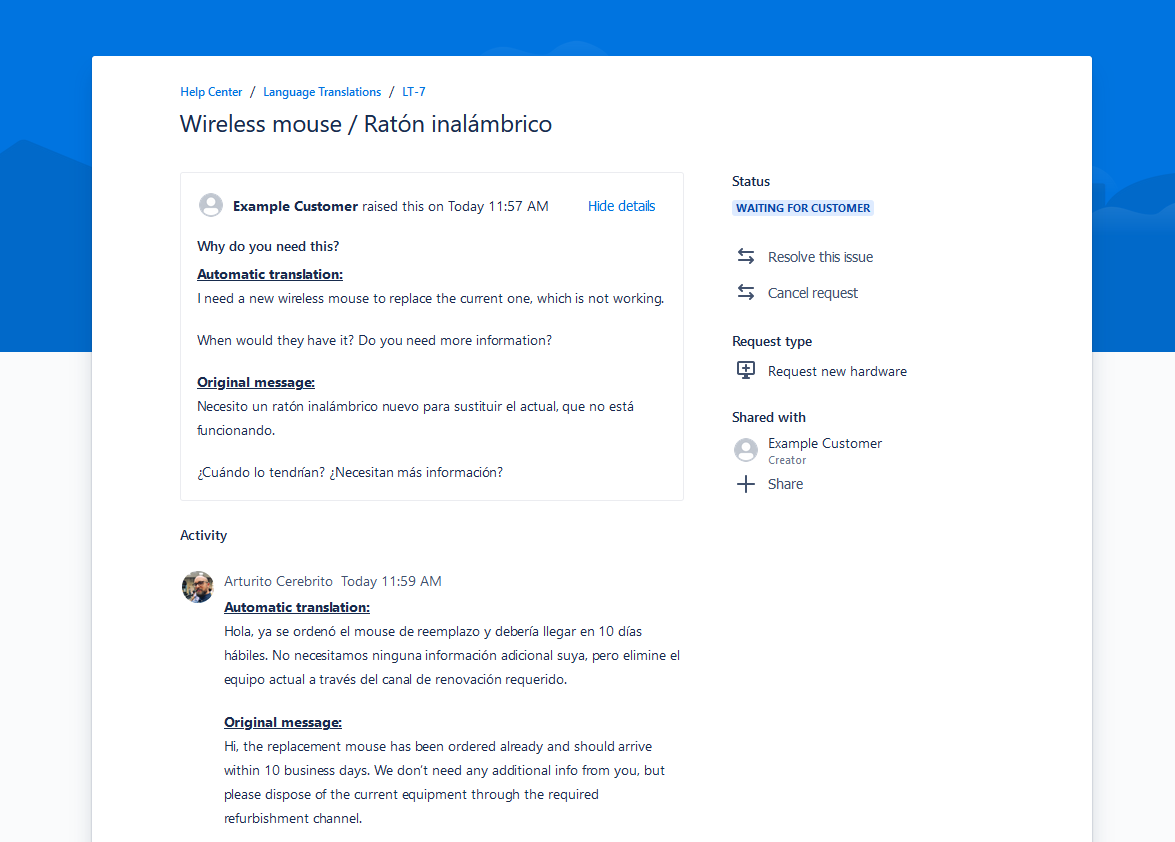
This also applies to the ticket summary and description.
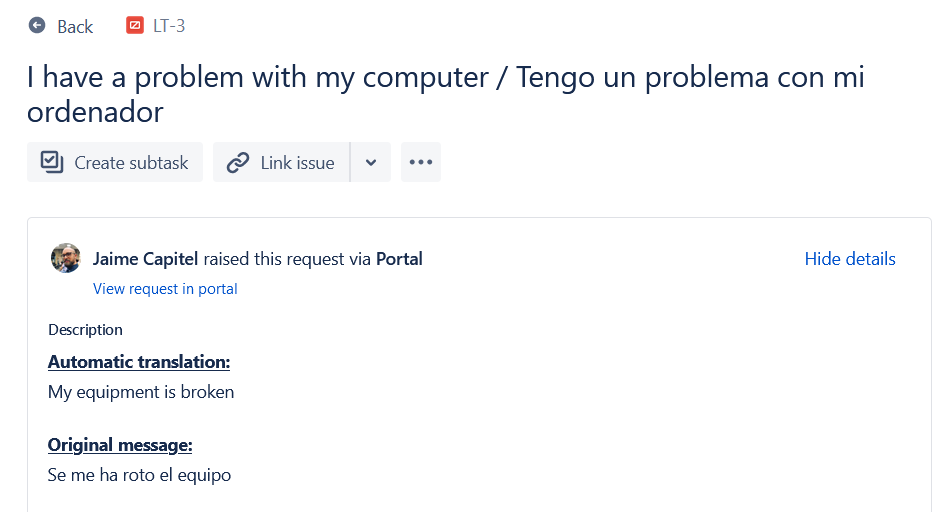
Invisible mode
The invisible mode creates a simpler experience for your customers when they interact with the Jira Service Desk portal. In this mode, the bilingual pairs of messages disappear and there are no labels to communicate whether a message has been translated or not.
By default, no agent messages to the customer will be translated in this mode. Instead, translations will only be sent when they are proactively triggered by an agent.
Benefits:
The invisible mode gives agents total control over which of their messages they want to send to the customer as a translation.
Customers will enjoy a cleaner Service Desk experience, including less email notifications.
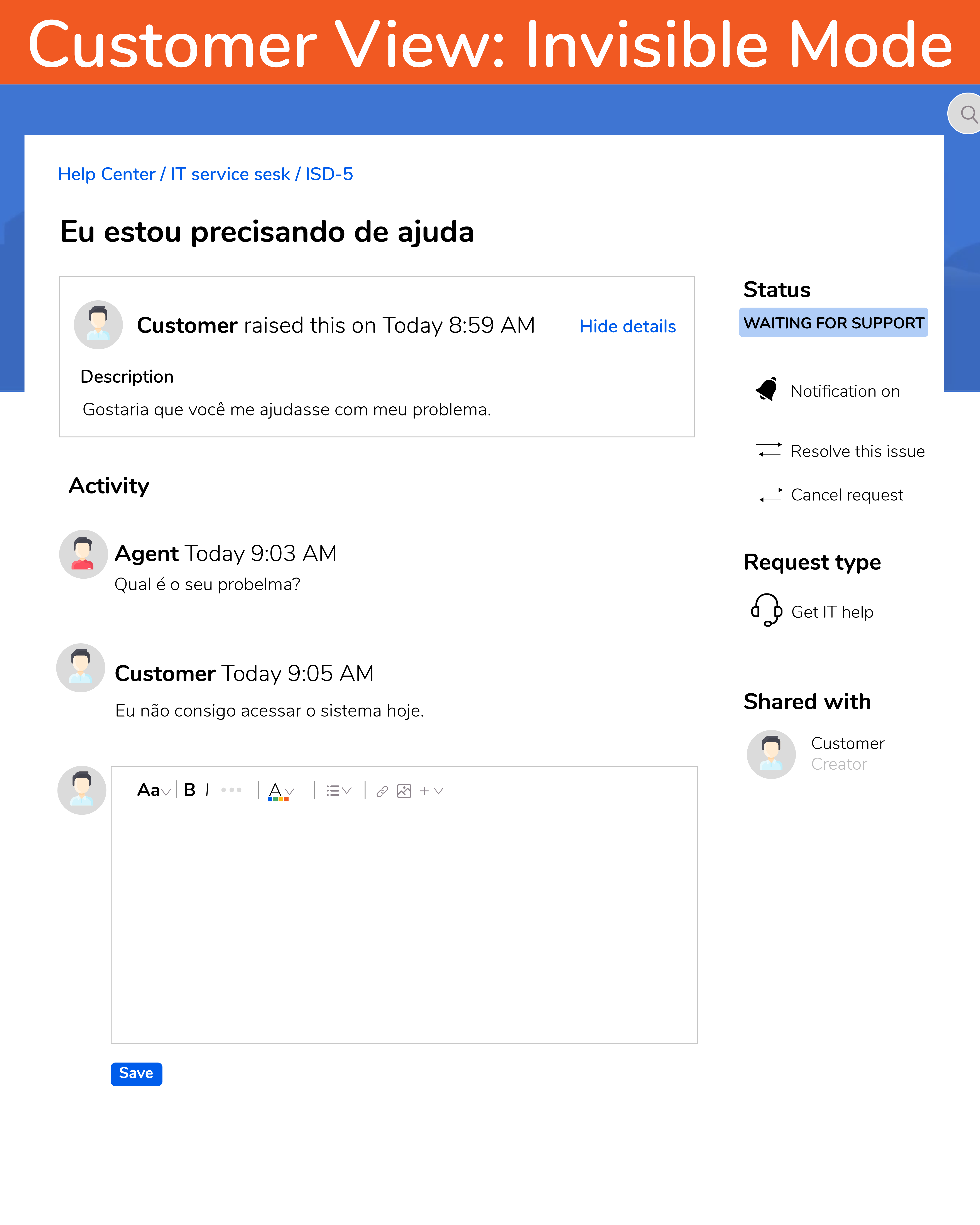 | 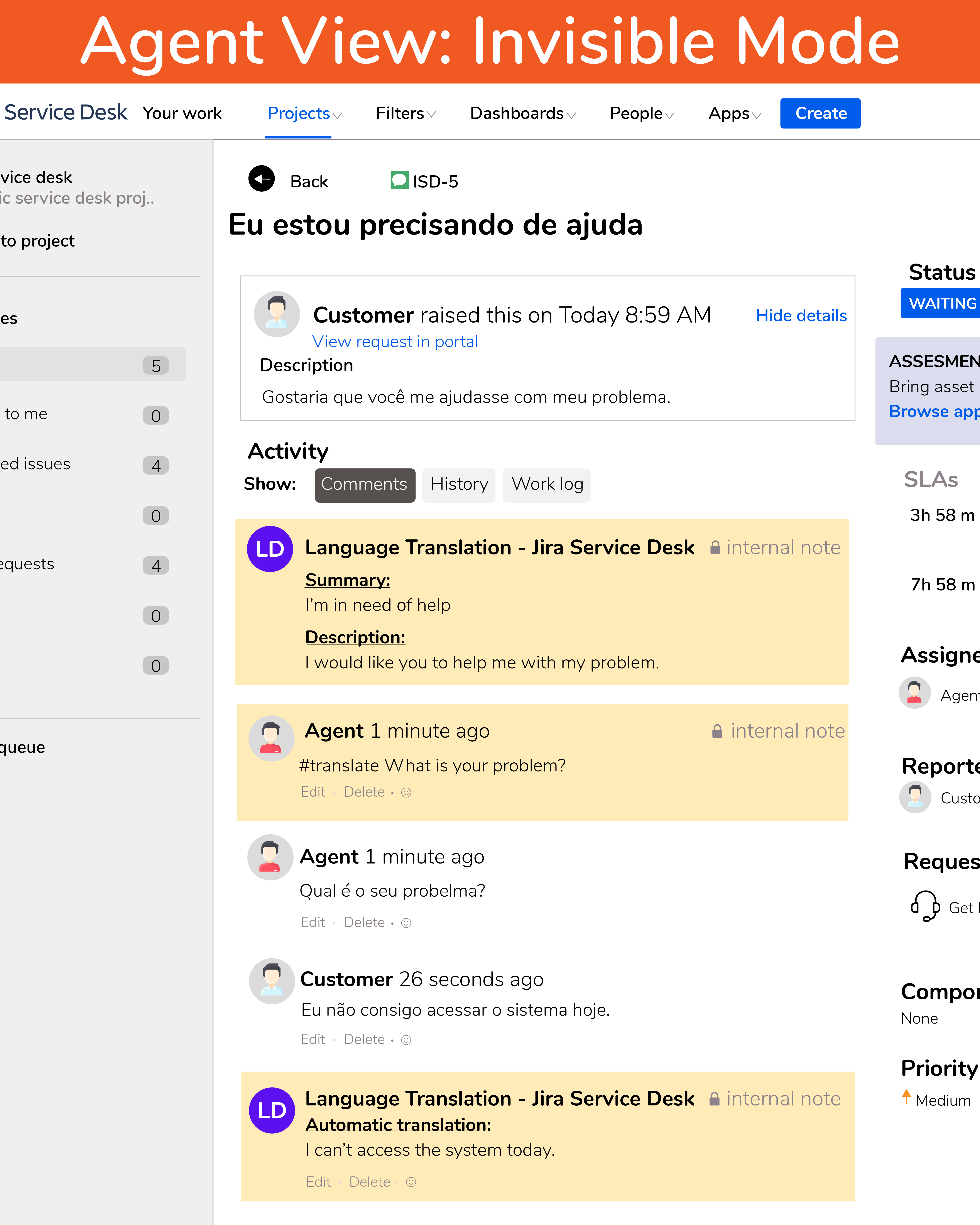 |
How to trigger the translation of agent messages in invisible mode with #translate
To trigger a translation as an agent:
create the message as an internal comment
start it with the command #translate
As a result, the internal comment will store the typed message, and an automated translation will be sent to the customer.
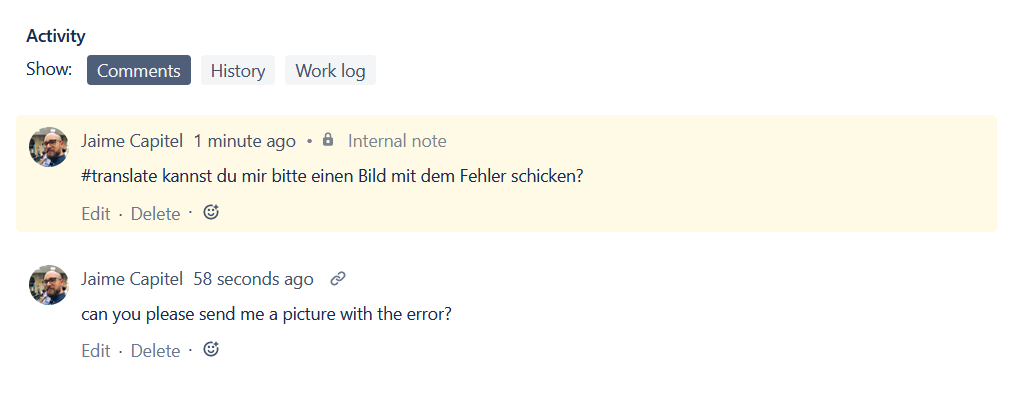
What do I need to remember about the invisible mode?
Messages submitted by the customer will still be shown in bilingual mode to the agent.
Direct messages from the agent to the customer will never be translated.
Translations will be triggered only for internal comments that start with #translate
When this happens, customers will only see the translated message, not the message stored in the internal comment
Neither the original message nor the automatic translation labels will be displayed in the customer portal.
4. Which languages are supported (can be translated)?
Below you will find a list of all languages our app use (or is able to translate). Our app use Google Translate in the background, but our list is a bit shorter (5 languages less) than the official language list from Google (https://cloud.google.com/translate/docs/languages).
- Afrikaans, af
- Albanian, sq
- Amharic, am
- Arabic, ar
- Armenian, hy
- Azerbaijani, az
- Basque, eu
- Belarusian, be
- Bengali, bn
- Bosnian, bs
- Bulgarian, bg
- Catalan, ca
- Cebuano, ceb
- Chinese (Simplified), zh-CN
- Chinese (Traditional), zh-TW
- Corsican, co
- Croatian, hr
- Czech, cs
- Danish, da
- Dutch, nl
- English, en
- Esperanto, eo
- Estonian, et
- Finnish, fi
- French, fr
- Frisian, fy
- Galician, gl
- Georgian, ka
- German, de
- Greek, el
- Gujarati, gu
- Haitian Creole, ht
- Hausa, ha
- Hawaiian, haw
- Hebrew, he
- Hindi, hi
- Hmong, hmn
- Hungarian, hu
- Icelandic, is
- Igbo, ig
- Indonesian, id
- Irish, ga
- Italian, it
- Japanese, ja
- Javanese, jw
- Kannada, kn
- Kazakh, kk
- Khmer, km
- Korean, ko
- Kurdish, ku
- Kyrgyz, ky
- Lao, lo
- Latin, la
- Latvian, lv
- Lithuanian, lt
- Luxembourgish, lb
- Macedonian, mk
- Malagasy, mg
- Malay, ms
- Malayalam, ml
- Maltese, mt
- Maori, mi
- Marathi, mr
- Mongolian, mn
- Myanmar (Burmese), my
- Nepali, ne
- Norwegian, no
- Nyanja (Chichewa), ny
- Pashto, ps
- Persian, fa
- Polish, pl
- Portuguese, pt
- Punjabi, pa
- Romanian, ro
- Russian, ru
- Samoan, sm
- Scots Gaelic, gd
- Serbian, sr
- Sesotho, st
- Shona, sn
- Sindhi, sd
- Sinhala (Sinhalese), si
- Slovak, sk
- Slovenian, sl
- Somali, so
- Spanish, es
- Sundanese, su
- Swahili, sw
- Swedish, sv
- Tagalog (Filipino), tl
- Tajik, tg
- Tamil, ta
- Telugu, te
- Thai, th
- Turkish, tr
- Ukrainian, uk
- Urdu, ur
- Uzbek, uz
- Vietnamese, vi
- Welsh, cy
- Xhosa, xh
- Yiddish, yi
- Yoruba, yo
- Zulu, zu
Currently, not supported
- Kinyarwanda, rw
- Odia (Oriya), or
- Tatar, tt
- Turkmen, tk
- Uyghur, ug
